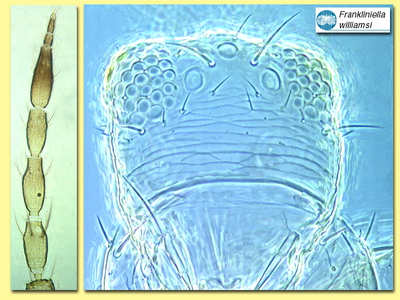Figures
Fig. 1 Antenna and head (dorsal)
Fig. 2 Pronotum
Fig. 3 Fore and hind wing
Fig. 4 Tergite II
Fig. 5 Tergite VIII
Species
Frankliniella williamsi Hood
Biology
Apparently breeding only on the young leaves of maize plants, on which it can cause linear markings due to feeding.
Distribution
Widespread in the tropics and subtropics of the New World, also recorded from Taiwan, Thailand, Philippines, New Guinea and northern Australia.
Recognition
Body and legs yellow, major setae not dark; antennae largely pale, VI brown with base yellow; forewings very slightly shaded. Head large, ocellar setae III longer than distance between two ocelli and arising just within anterior margins of ocellar triangle; postocular setae almost as long as ocellar setae III. Antennae slender, III & IV with sense cone forked, VIII longer than VII. Pronotal setae exceptionally long and slender, 2 pairs on anterior margin commonly with 2 pairs of minor setae medially, 2 pairs of posteroangulars almost half as long as median length of pronotum, and one pair of posteromedian setae. Metanotum with median setae arising at anterior margin and almost reaching posterior margin of sclerite. Forewing with both longitudinal veins bearing complete row of setae. Tergites V-VIII each with a ctenidium laterally, on VIII anterolateral to spiracle; tergite VIII posterior margin with a complete posteromarginal comb of regular slender microtrichia. Sternite II usually with one or two discal setae medially. Male sternites III-VII with transverse glandular area; tergite IX median pair of setae stout.
Related species
F. williamsi is usually distinguishable from the other yellow species of this genus by the presence of one or two discal setae medially on the second sternite, but in the southern USA and Central America the polyphagous species, F. gossypiana Hood, is particularly similar although with a more slender head.






